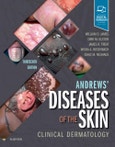Now in a fully revised thirteenth edition, Andrews' Diseases of the Skin remains your single-volume, must-have resource for core information in dermatology. From residency through clinical practice, this award-winning title ensures that you stay up to date with new tools and strategies for diagnosis and treatment, new entities and newly recognized diseases, and current uses for tried-and-true and newer medications. It's the reference you'll turn to again and again when faced with a clinical conundrum or therapeutically challenging skin disease.
- Utilizes a concise, clinically focused, user-friendly format that clearly covers the full range of common and rare skin diseases.
- Provides access to approximately 20 videos online, depicting chemical peels, Q-switched laser tattoo removal, ED&C (electrodesiccation and curettage), nerve block, and more.
- Provides outstanding visual support with 1,340 illustrations - more than 500 new to this edition.
- Presents comprehensively updated information throughout, including new and unusual clinical presentations of syphilis, new diagnostic classifications and therapies for vascular anomalies, and an updated pediatric and genodermatosis review.
- Covers new and evolving treatments for inflammatory, neoplastic, and blistering skin diseases among others. New biologics and phosphodiesterase inhibitors for psoriasis and atopic dermatitis, JAK inhibitors for alopecia areata and vitiligo, immune checkpoint inhibitors for melanoma and rituximab for pemphigus are all covered.
- Features a revised and revamped cutaneous adverse drug reaction section, including novel eruptions from new and emerging chemotherapeutic agents and small molecule/targeted inhibitors.
- Discusses new and emerging viruses including Zika and human polyomaviruses.
- Enhanced eBook version included with purchase. Your enhanced eBook allows you to access all of the text, figures, and references from the book on a variety of devices.
Table of Contents
1. Skin: Basic Structure and Function
2. Cutaneous Signs and Diagnosis
3. Dermatoses Resulting from Physical Factors
4. Pruritus and Neurocutaneous Dermatoses
5. Atopic Dermatitis, Eczema, and Noninfectious Immunodeficiency Disorders
6. Contact Dermatitis and Drug Eruptions
7. Erythema and Urticaria
8. Connective Tissue Diseases
9. Mucinoses
10. Seborrheic Dermatitis, Psoriasis, Recalcitrant Palmoplantar Eruptions, Pustular Dermatitis, and Erythroderma
11. Pityriasis Rosea, Pityriasis Rubra Pilaris, and Other Papulosquamous and Hyperkeratotic Diseases
12. Lichen Planus and Related Conditions
13. Acne
14. Bacterial Infections
15. Diseases Resulting from Fungi and Yeasts
16. Mycobacterial Diseases
17. Hansen's Disease
18. Syphilis, Yaws, Bejel, and Pinta
19. Viral Diseases
20. Parasitic Infestations, Stings, and Bites
21. Chronic Blistering Dermatoses
22. Nutritional Diseases
23. Diseases of Subcutaneous Fat
24. Endocrine Diseases
25. Abnormalities of Dermal Fibrous and Elastic Tissue
26. Errors in Metabolism
27. Genodermatoses and Congenital Anomalies
28. Dermal and Subcutaneous Tumours
29. Epidermal Nevi, Neoplasms, and Cysts
30. Melanocytic Nevi and Neoplasms
31. Macrophage/Monocyte Disorders
32. Cutaneous Lymphoid Hyperplasia, Cutaneous T-Cell Lymphoma, Other Malignant Lymphomas, and Allied Diseases
33. Diseases of the Skin Appendages
34. Disorders of the Mucous Membranes
35. Cutaneous Vascular Diseases
36. Disturbances of Pigmentation
37. Dermatologic Surgery
38. Laser Surgery
39. Cosmetic Dermatology








